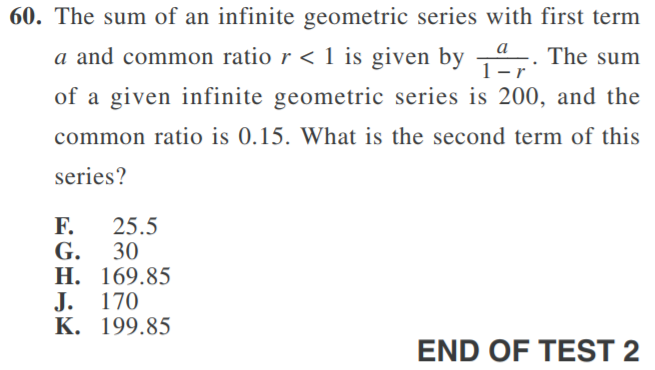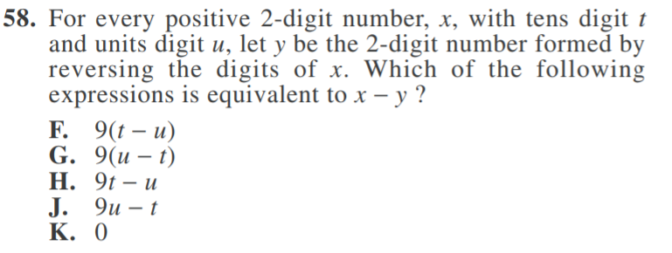Need help on the ACT Math section? Today I will go over some of what I believe to be the hardest problems on the ACT and how to go about solving them quickly and efficiently. While every student has different strengths and weaknesses, the problems I have selected seem to be the most representative of what students have trouble with.
The source of these problems is from the “Preparing for the ACT” booklet from 2011-2012 (form code 64E). You can find more practice tests and the Best ACT Prep course ever at our website supertutortv.com.
Question #1: Sequences and series
Sequences and series are often difficult since the subject is seldom taught in depth or at all at many high schools. Many students don’t know all of the terminology used to describe the behavior of series which makes these questions very confusing.

First, reading the problem we get some vital information. We are told the formula for the sum of an infinite geometric series, given that the common ratio r is less than 1. Notice here that we have not been given a, the first term of the series. Instead we have been given the sum of the infinite geometric series, which we can call s, which is 200.
This is what I would like to call a function as a model problem. Not only is this a sequences and series problem, but also a general problem solving question in that you have been given an equation, either explicitly or implicitly, and you must use it to extract new information and solve the problem.
In order to solve this problem, let’s first plug in what we know. We are given r, the common ratio (0.15), and s, the sum of the series (200). Now we plug these values into the given equation to get 200 = a/(1 – 0.15). Now we only have one unknown and we can solve for a. The expression can be rewritten as 200 = a/0.85, and then multiplying both sides by 0.85, we get that a = 170.
If you’re in a rush, you might just circle answer choice J. and go on to the next question. But that would be incorrect – let’s read the question again: “What is the second term of this series?” The first term of the series is a, which is equal to 170. Basic knowledge about geometric series tells you that you acquire the next term in the series by multiplying by the common ratio. If you want to find the nth term of the series, you multiply the first term a by the common ratio r raised to the (n-1) power. Since we want the second power, we multiply a by r raised to the first power:
170 x 0.15 = 25.5.
Your answer is choice F. 25.5
The key skills you need here are knowing how to approach function as a model questions, as well as how geometric sequences work. For the ACT, be sure to also know how arithmetic sequences work and try to do a few practice problems.
Question #2: Properties of numbers

I like to call these kinds of questions properties of numbers questions. Other questions like this will often involve integers, evens, odds, primes, and other similar mathematical ideas. These kinds of problems aren’t really taught in school, but rather are solved through the understanding of basic mathematical principles.
The key to solving this problem is not by plugging and chugging, which would be many student’s first guess. Not only would this method take more time, but it also can yield wrong answers depending on which numbers you pick. Instead, let’s take an algebraic approach.
We are told that the 2-digit number x has tens digit t and units digit u. So, the number 35 would have t = 3 and u = 5. Let’s think about what this really means. If you are given t and u, how would you go about finding that number that x represents? Since t is the tens digit, we know that t = 3 actually represents 3 times 10, or 30. Likewise, since u is the ones digit, we know that u = 5 actually represents 5 times 1, or 5. Summing 30 and 5, we get our number x.
The point of all of this is that the number x can be represented with an algebraic expression using t and u. Since t is in the tens digit, we represent this with 10t, and since u is in the ones digit, we represent this with just u. Summing these, we get that x = 10t + u.
Performing the same process for y, taking into account that the digits are now reversed, we get y = 10u + t. Notice that we now have x and y represented as algebraic expressions of t and u, which is what we want! Now we simply perform the subtraction x – y in terms of the new variables.
(10t + u) – (10u + t) = 9t – 9u
Factoring out a 9, we get 9(t – u), which is the same as answer choice F. 9(t – u)
While that may be it for problems for this video, I can leave you all with some types of math problems that many students need to brush up on before taking the test.
1. Arrangements, combinations, and permutations problems
2. Probability
3. Sequences and series
4. Vectors
5. Matrix operations
At the very least, do some practice that involve these kinds of problems, just to make sure that you have them down. Other than that, I hope this was helpful! Good luck studying!




